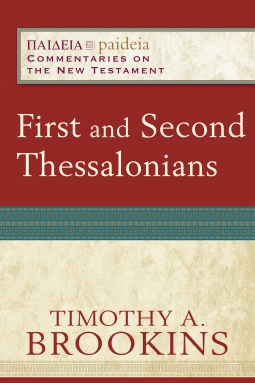
First and Second Thessalonians
by Timothy A. Brookins
This title was previously available on NetGalley and is now archived.
Send NetGalley books directly to your Kindle or Kindle app
1
To read on a Kindle or Kindle app, please add kindle@netgalley.com as an approved email address to receive files in your Amazon account. Click here for step-by-step instructions.
2
Also find your Kindle email address within your Amazon account, and enter it here.
Pub Date 16 Nov 2021 | Archive Date 16 Jan 2022
Baker Academic & Brazos Press | Baker Academic
Talking about this book? Use #FirstandSecondThessalonians #NetGalley. More hashtag tips!
Description
Available Editions
| EDITION | Other Format |
| ISBN | 9780801031823 |
| PRICE | US$34.00 (USD) |
| PAGES | 256 |
Average rating from 1 member
Featured Reviews
 Conrade Y, Reviewer
Conrade Y, Reviewer
When studying the Bible, one of the key emphases is to interpret the texts in the right context. That usually means trying to understand the literary and cultural situations back in ancient times prior to applying them to our present world. This commentary series goes much further and deeper to build the "theological convictions and moral habits" of readers. Instead of verse-by-verse, the commentary moves in terms of "rhetorical units." Within each unit, readers learn about the introduction, the narrative flow, and the theological themes. The introduction includes matters such as the identity of the author, the intended audience, the background, and an overview of the letter. Noting how little attention has been paid to the nature of the 2 books as letters, author and professor Timothy Broookins pays special attention to the letter genre to make sense of its literary composition. Using the nature of the letter as an interpretive lens, to understand the ancient contexts, the authorial intent, audience, history, cultural backgrounds, and so on. He goes further to point out that Paul's letter in a "literary" one rather than a "nonliterary" or a "diplomatic" one. It gives us a glimpse of Paul's narrative, being forced out of Thessalonica by the opposition. It was a tumultuous time as Christians in the region continue to be persecuted. Taken together with Acts, one could roughly piece together the places Paul had gone. Questions remain whether the reasons for the letter were situational, social, political, doctrinal, or even "anti-imperial." Some of the theological themes are:
- Apocalyptic literature to clarify end-times understanding
- A sense of family ties during tough times
- Learning to see how God was working then
- Christian virtue
- Freedom
- Various teachings and exhortations
Brookins uses a common framework for each segment of Scripture:
- Introductory Matters
- Tracing the Train of Thought
- Theological Issues
Within each section, readers get to learn about how the theological themes are applied within the background of the Church situation. For instance, the gospel was presented as an encouragement to the Christians suffering persecution. At the same time, the teachings of eschatology help to give hope to the believers in the light of difficult times. What is most interesting is the way Brookins traces the trend of Paul's thought. We learn of the reasons behind Paul's enthusiastic thanksgiving. For he himself knew the challenges in being a minister and witness for Christ. The theological issues discussed help readers maintain a consistent understanding of Paul's key points throughout the letter.
My Thoughts
==============
Brookins gives us a unique angle to interpreting the letters to the Thessalonians. Rather than to simply comment laboriously verse-by-verse, he chooses specific segments amid a challenging background faced by the believers at that time. By painting a detailed contextual picture for us, we get to appreciate the reasons why Paul wrote the letter. The author has done well to help us pay greater attention to the cultural, literary, and theological settings needed to help us interpret the texts. Just like the way we learn Inductive Bible Studies, once we learn to observe the text well, the rest of the process (Interpretation and Application) would flow in quickly and easily. What I like about Brookins's approach is that it forces one to slow down to sense the environment that Paul and the Early Church were facing. That is crucial for modern readers in the West like us who sit in comfortable homes, attend Church in safe settings, and often able to worship with fellow believers without much interference from religious or political powers. Imagine our Church leaders being chased out of buildings or persecuted by authorities, and then having to find ways to reconnect with our fellow brothers and sisters to encourage them to persevere in the faith. In contrast to our modern convenience of travel and the comfort of being able to worship peacefully, when we put ourselves in the shoes of the Early Church, it should make us more conscious of how blessed we are right now in our modern world.
We should not rush to apply the texts, lest we misapply. This commentary forces us to learn the actual background before taking in the theological themes. The best way to use this book is still the same. First, read the original letter as is, if necessary, twice. Then let the commentary guide us back to the texts as often as possible, letting Brookins guide us like an able teacher. Once we learn that, the applications should flow pretty quickly. This commentary is unique and should supplement anyone desiring to teach or discuss more on the two letters to the Thessalonians.
Timothy A. Brookins (PhD, Religion, Baylor University) is Associate Professor of Classics and Biblical Languages at Houston Baptist University. His research focuses on the New Testament and its context. He specializes in the Greco-Roman context of early Christianity, with a primary emphasis on the Pauline epistles.
Rating: 4.25 stars of 5.
conrade
This book has been provided courtesy of Baker Academic and NetGalley without requiring a positive review. All opinions offered above are mine unless otherwise stated or implied.



